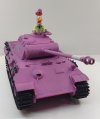It depends, and there's not really a right or wrong answer, but whichever works best for you, and your son.
I start by looking at the kit and seeing how hard it's going to be to paint things at different points in the process. If I can prime the whole kit on the sprues at the start, and not create a lot of work for myself downstream, I'll do that. If there are areas I won't be able to get to once they're in place, I'll prime and paint them, then install them.
With an airplane or a tank, I'll prime the interior and interior parts, assemble them, and then close up the fuselage or the body. It's easy to plug openings like cockpits or hatches with damp paper towel or facial tissue, then prime the exterior.
The downside to priming on the sprues is that as I remove parts as I build, I usually have to clean up the sprue attachment points and then decide to touch up the primer at that spot, or not.
I usually do prime everything, but remember that priming isn't just a surface prep to improve adhesion of finish color coats. Priming can reveal flaws in the surface that you might not otherwise see. It can make it easier to see fine seams or gaps that you might have missed, and which you may want to address before applying finish colors. With water-based acrylics, like Vallejo or Andrea acrylics, or craft-store acrylics (the kind you find at Michael's, HobbyLobby, WalMart) like Americana, Folk Art, or Apple Barrel, it definitely helps those paints adhere to the surface. Enamels and lacquers are chemically "hotter" and can adhere to the styrene well on their own.
But again, for me, it always comes back to what makes sense, what makes less work, during the process.
Hope that helps!
Brad

